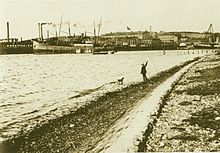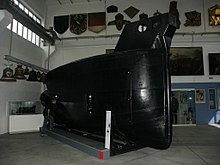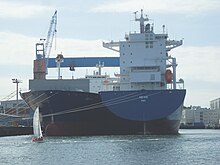Howaldtswerke-Deutsche Werft
| Howaldtswerke-Deutsche Werft GmbH ThyssenKrupp Marine Systems GmbH
|
|
|---|---|
| legal form | GmbH |
| founding | October 1, 1838/1968 |
| Seat |
Kiel , Germany |
| Number of employees | 2400 |
| Branch | Shipbuilding |
| Website | hdw.de |

The Howaldtswerke- German Werft GmbH ( HDW ) in Kiel was in the end of 2012 , ThyssenKrupp Marine Systems GmbH renamed (TKMS). The company history of the largest German shipyard goes back to the founding of an iron foundry and steam boiler construction company in 1838.
background
The company was created in 1968 from the merger of Howaldtswerke Hamburg AG with Kieler Howaldtswerke AG, Kiel and Deutsche Werft AG . Since the merger with ThyssenKrupp shipyards on January 5, 2005, HDW was a GmbH subsidiary of the ThyssenKrupp Marine Systems AG holding company . HDW GmbH was renamed TKMS GmbH upon entry in the commercial register on December 10, 2012. The company is now known primarily for its submarines with fuel cell drive of 212 Class A , which in cooperation with the North Sea works built Emden.
The federal government is promoting the export of submarines with loan commitments and purchase subsidies - as it did in March 2010 to Greece : At that time, the German government is said to have demanded two “Poseidon-class” submarines from Greece as a prerequisite for concessions when designing the rescue package . (Type 214) to buy under license from HDW for one billion euros.
The shipyard has also designed and manufactured innovative prototypes in the civil sector, such as B. the largest container ships of the time for the APL ( American President Line ) or the world's first container ships without hatches for the shipping company Norasia. In the recent past, mostly prototypes have been developed and manufactured on HDW and follow-up structures have been built under license in the client's country. Today this particularly applies to so-called “package” contracts in submarine construction. This procedure is controversial: it secures the "innovation location Germany", but not the jobs in the production. Theft of intellectual property by foreigners cannot be ruled out.
history

Mechanical engineering company and iron foundry Schweffel & Howaldt (1838)
On October 1, 1838, the engineer August Ferdinand Howaldt and the wealthy Kiel merchant Johann Schweffel founded the "Maschinenbauanstalt und Eisengießerei Schweffel & Howaldt", which manufactured boilers, steam ovens and machines for agriculture in Schleswig and Holstein in Kiel . In 1849 the first steam engine for a seagoing ship was made, the gunboat Von der Tann of the Schleswig-Holstein Navy . After the Nautilus , which had been tried out fifty years earlier in France , Schweffel & Howaldt built the first German submarine , the Brandtaucher , in 1850 ; to be seen today in Dresden in the Military History Museum of the Bundeswehr . The building in Kiel was more of a coincidence, because during the Schleswig-Holstein War the Danes had already come too close to the originally planned building site in Rendsburg .
However, the main field of activity was still the construction of steam engines, occasionally small ships were built, in 1860 the tugboat Kiel and in 1864 the tugboat Schwentine .
In 1879 Johann Schweffel jr. , the son of the co-founder of "Schweffel & Howaldt", left the company and the company was continued by the three sons of August Ferdinand Howaldt, Georg , Bernhard and Hermann Howaldt as "Maschinenfabrik Gebrüder Howaldt".
Georg Howaldt had already built a small shipyard in 1865 on a rented site near Ellerbek , where a small 93- GRT steamer called Vorwärts was launched in the same year . This shipyard, which was taken over by the North German Confederation in 1867 , then became the Königliche Werft Kiel ( renamed Kaiserliche Werft Kiel after the establishment of the German Empire in 1871 ).
In 1876 Georg Howaldt founded the Kiel shipyard in Dietrichsdorfer Feldmark at the mouth of the Schwentine on a 440 m² site, initially employing 95 workers. The new company expanded rapidly; In 1883, 1195 workers were already working on the 6600 m² area. The shipyard purchased machines and accessories for the ships from the Howaldt brothers' machine factory . This soon proved to be too small, and a new machine factory was built next to Georg Howaldt's shipyard, which was opened in 1883. A separate dock company was founded to operate a floating dock in order to be able to carry out ship repairs. Of this Wilhelminian style shipyard, only the " old metal foundry ", built in 1884 by the most famous Kiel architect of his time, Heinrich Moldenschardt , remains today , which was expanded to become an industrial museum.
Howaldtswerke (1889 to 1917)
On June 22, 1889, the Howaldt brothers machine factory and the Kiel shipyard were merged by Georg Howaldt, formerly Reuter & Ihms , to form the Howaldtswerke stock corporation . The company's headquarters were in Dietrichsdorf on the east bank of the Kiel Fjord, where shipbuilding was carried out until 1983.
By the turn of the century, 390 steamers had left the shipyard. During the First World War , some torpedo boats were built for the Imperial Navy . The Howaldtswerke benefited from the fact that Kiel was developed into the central port of the German Navy during this time.
After the death of his youngest brother Herrmann in 1900 and the departure of Bernhard Howaldt, Georg Howaldt ran the company with his eldest son AJ Georg .
In 1897, after the fire diver, the so-called test submarine was built at Howaldt as the second submarine , but it was not technically convincing. Up until the beginning of the Second World War, the Howaldtswerke were no longer involved in building submarines on a large scale, but concentrated on large ships for the Imperial Navy. Before the First World War the workforce grew to 3,000 men. The liner SMS Helgoland was built from 1908 to 1911, and in 1908 the first ship with a turbo-electric drive, the submarine lifting ship SMS Vulkan . The ship of the line SMS Kaiserin followed in 1911 and in 1916 the SMS Bayern was one of the last completed ships of the line of the Imperial Navy . In addition, from 1917 the construction of the large torpedo boats H 145 to H 147 followed .
Howaldtswerke AG, Kriegsmarinewerft Kiel (1918 to 1945)

After the end of the war in 1918, the shipyard in Kiel faced a near bankruptcy and held out. a. with work for the Deutsche Reichsbahn über Wasser.
In 1926 the shipyard was about to be liquidated , but the owner of the Schwentine-Dock-Gesellschaft, which is closely related to the company, Heinrich Diederichsen , acquired the majority of the shares and continued to operate Howaldtswerke AG .
The Vulkan-Werke Hamburg was taken over in 1930 by the Deutsche Schiff- und Maschinenbau Aktiengesellschaft (Deschimag) and continued to operate together with the insolvent Janssen & Schmilinsky shipyard as Howaldtswerke AG Kiel, previously Vulcan department .
The global economic crisis at the end of the 1920s reduced the activity of all shipyards to a minimum; It was not until 1934 that the armament of the Reich and Kriegsmarine began to revive.
Heinrich Diederichsen sold his Howaldt shares in March 1937 to the state-owned Deutsche Werke AG , based in Berlin, and the two Howaldt locations in Hamburg and Kiel became independent units. Felix Scheder-Bieschin († 1940), who had previously been director of the Emden Nordseewerke from 1934, became the board of directors in Kiel .
On April 1, 1939, the Navy took over the Kiel shipyard in Neumühlen-Dietrichsdorf and continued to run it with the facilities of the Kiel Naval Arsenal as the Kiel Navy shipyard with a workforce of 17,730 people (1941). The profitability of this state-owned company was unsatisfactory and therefore on July 1, 1943 the Howaldtswerke, which had been based in Hamburg from 1939, bought back the Kiel location.
During the Second World War , the Howaldtswerke (including the Kiel Navy Shipyard) built a total of 64 VIIC submarines (33 of them in Hamburg and 31 in Kiel). The Kilian submarine bunker was built for this purpose at the Kiel shipyard from 1941 to 1943 .
At the end of the war, 80% of the buildings and 60% of the machines in Kiel were destroyed or no longer operational. In the Hamburg plant, 36% of the buildings, 12.5% of the machines and 22% of other systems were unusable. Of the three major Kiel shipyards, Germaniawerft , Deutsche Werke Kiel / DWK and Howaldt, only the Howaldt works were not dismantled.
Kieler Howaldtswerke AG, Kiel and Howaldtswerke Hamburg AG (after 1945)
At the beginning of 1953, the two shipyards in Hamburg and Kiel became independent companies again, as in 1939. The Kiel shipyard was now called Kieler Howaldtswerke AG, Kiel ; the other location Howaldtswerke Hamburg AG . In November 1954, the Howaldtswerke in Kiel merged with DWK, whose shipyards in Kiel- Gaarden were almost completely dismantled after 1945. The largest slipway No. 3 on the former DWK site, which was now called Kieler Howaldtswerke AG, Gaarden plant , was restored as the new slipway I and expanded for ships up to 80,000 dwt . By the end of the 1950s, a new 11-meter-high shipbuilding hall with an area of 5500 m² and, in addition to the two existing dry docks No. V and VI of the former DWK, two new building docks (Dock 7 and 8) for ships up to 85,000 and 120,000 dwt. In 1956 the workforce comprised over 13,000 people.
In the economic miracle of the 1950s the shipbuilding flourished: among other things, let Aristotle Onassis some of its tankers (for example, the. Tina Onassis ) at Howaldt build.
Fusion to HDW
At the end of 1968, the two Hamburg shipyards Howaldtswerke Hamburg and Deutsche Werft signed a business lease and order transfer agreement with Kieler Howaldtswerke with the new company Howaldtswerke-Deutsche Werft AG (HDW), which was owned equally by the Salzgitter Group and Deutsche Werft AG. The total workforce at HDW at the time it was founded was 21,684. In 1969 the Hamburg and Kiel stock companies merged and were converted into a GmbH in 1970. On January 1, 1972, the Salzgitter Group took over the shares in Deutsche Werft AG and was now the sole owner of Howaldtswerke. In 1973 the previously leased fixed assets of the Deutsche Werft in Finkenwerder were bought and shipbuilding there was stopped. The HDW location in Hamburg was completely given up in the 1980s. The Reiherstieg plant ceased operations in 1982/83; the Ross plant, the former volcano shipyard, followed two years later in 1985.
Extensive investments required a capital increase in 1975 , which led to the state of Schleswig-Holstein taking a 25.1% stake in HDW. These shares were sold again by the country in the 1990s.

Already in 1968 the submarine construction in Kiel had moved to the area of the former large engine factory Buckau-Wolf (until 1956 Bohn & Kähler ). The site, known as the Kiel-Süd plant of the then Kiel Howaldtswerke , was part of the Germania shipyard until 1945 and was closed again in 1989.
The outdated main factory in Dietrichsdorf was shut down in the early 1980s and operations were completely concentrated in the modern facilities in Gaarden (formerly Kaiserliche Werft / DWK). In 1983 the Dietrichsdorf works on the Schwentine estuary, where the first shipyard founded by Georg Howaldt was established in 1876, was abandoned and the site was sold to the city of Kiel in December 1984. The remains of the Kilian submarine bunker there were removed around 2000 and the area was used to expand the Ostuferhafen . Today there is u. a. the pier for the ferry to Klaipėda of the Lithuanian shipping company AB DFDS LISCO .
In 1981 the turnover of HDW was 1.01 billion DM, but recorded an annual loss of 85 million DM.
In 1986 the company was involved in an investigation by the German Bundestag ( main article : submarine plans investigation committee ). HDW had delivered submarine blueprints to South Africa despite an embargo at the time .
From the 1990s onwards, HDW renovated itself in order to be able to withstand competition from the Far East. Container shipbuilding in particular came under great pressure. Through purchases of the Swedish Kockumswerft , the Greek Hellenic Shipyards and cooperations, HDW transformed into an international group .
Today's TKMS shipyard in Kiel- Gaarden on the east bank of the Kiel Fjord extends over the area of the two former Kiel shipyards, Kaiserliche Werft / DWK / Howaldtswerke and Germaniawerft .
21st century
Together with its subsidiaries , the HDW Group employs around 6,600 people in Germany, Greece and Sweden.
The group is based in Kiel, with main activities in Kiel, Karlskrona and Malmö in Sweden and Skaramagas in Greece. One focus is the construction of submarines . With modern hydrogen technology , a leading position in conventional submarine construction is taken internationally. The first stealth corvettes in the world also came from the subsidiary Kockums AB in Sweden.
In March 2002, the American financial investor One Equity Partners (OEP) took over the majority in HDW from Babcock AG . When Babcock had to file for bankruptcy shortly afterwards , Babcock AG asked OEP to reverse the sale. However, this demand was averted.
HDW has been part of TKMS since 2005, to which u. a. Blohm + Voss in Hamburg belonged. To this end, ThyssenKrupp AG took over HDW from the US financial investor OEP One Equity Partners in return for a 25% stake in the new ThyssenKrupp Marine Systems holding company . The contract was approved by the antitrust authorities. HDW-Hagenuk Schiffstechnik was transferred to Imtech Marine & Offshore as part of this procedure . Initially, all locations are to be retained. In the long term, a European network is to be sought. The deal was controversial: On the one hand, according to the plans of ThyssenKrupp, the corporate headquarters of TKMS was relocated to Hamburg, the entire surface shipbuilding should actually remain in Emden and in Kiel only the submarines remained. The unions and those working there fear the loss of up to 1,000 jobs in Kiel.
In the meantime HDW had taken the lead in the underwater area within TKMS. The civil overwater activities were outsourced to HDW-Gaarden GmbH on July 1, 2005 , which was located on the same company premises, but was independent in terms of booking. In 2011, HDW-Gaarden GmbH was taken over by Abu Dhabi MAR (ADM) and was initially renamed "Abu Dhabi MAR Kiel GmbH" (ADMK). It has been operating under the name German Naval Yards since March 2015 .
In the underwater area, the departments involved in the former consortium partner NSWE were made divisional under the management of HDW.
The shipyards Hellenic Shipyards (HSY) in Greece and Kockums AB in Sweden, which HDW brought into TKMS, are no longer part of the "HDW Group", but have been operated as parts of ThyssenKrupp Marine Systems , but so far without changing the previous corporate forms. HSY was acquired by ADM in 2011.
The container carriers NB418 and NB419 , ordered by the Buxtehuder shipping company NSB Niederelbe Schiffahrtsgesellschaft and completed in 2010, each with a loading capacity of 3,400 standard containers, are the largest container carriers built by HDW for more than twelve years. The order for the new NB420 building, which had already started , was canceled, the shell, in which 4,000 tons of steel had already been installed, was scrapped.
In October 2011 it became known that suspected corruption millions of payments had flowed from HDW to a South Korean sales partner. ThyssenKrupp then announced that it would check the payments - also in response to the suspicion of corruption at the engine manufacturer Tognum , which is said to have been doing business with the HDW partner.
Restructuring of ThyssenKrupp Marine Systems at the end of 2012
At the end of 2012, the ThyssenKrupp Marine Systems division was rebuilt as part of the restructuring of the ThyssenKrupp Group. The traditional Kiel shipyard HDW was renamed ThyssenKrupp Marine Systems GmbH on December 10, 2012 . ThyssenKrupp has combined the two business areas of plant engineering and marine shipping in the Industrial Solutions area, which also includes ThyssenKrupp Marine Systems operations in Kiel (previously HDW), Hamburg (previously Blohm + Voss Naval), Emden (also Blohm + Voss Naval) and Swedish Karlskrona (Kockums) belong. The name "HDW" is thus industrial history. In future, Kiel will have the status of an umbrella company for the ThyssenKrupp Marine Systems locations.
Known ships or ship classes built by HDW
In its history, HDW has built well over 1500 ships. These are:
- SMS Vulkan (1908), first German submarine lifting ship
- Otto Hahn (1968), nuclear freighter
- Hamburg (1969) built as a passenger steamer and cruise ship in the Finkenwerder plant by HDW for the Deutsche Atlantic Line Hamburg , later in service for many years under the Soviet and Russian flags as Maxim Gorkiy ; Scrappedat the scrapping yards near Alang (India) in2009
- FS-1500 frigates from 1981
- Polarstern (1982), polar research ship
- Astor (1987), cruise ship
- Prinsesse Ragnhild (1981), RoRo ship
- Germany (1998), flagship of the Peter Deilmann Reederei and " Das Traumschiff "
- Multi-purpose ships of the CL10 series , from 1977
- Bonn Express class ships, from 1989
- Octopus (2003), mega yacht
- U 31 (2004), the most modern fuel cell submarine in the world
- A (2008), mega yacht
literature
- Eberhard Rössler: The German submarines and their shipyards . Bernard & Graefe Verlag, Koblenz 1990, ISBN 3-7637-5879-8
- Christian Ostersehlte: From Howaldt to HDW . Koehlers Verlagsgesellschaft, Hamburg 2004, ISBN 3-7822-0916-8
- Jürgen Rohweder: Only change is constant… In: Hansa , issue 10/2013, Schiffahrts-Verlag Hansa, Hamburg 2013, ISSN 0017-7504 , pp. 60–68.
- Hans H. Meyer: The ships of Howaldt and HDW. Volume 1: New buildings and conversions by Howaldtswerke AG in Kiel from 1945 to 1967 . Oceanum Verlag eK, 1st edition, 2013, ISBN 978-3-86927-071-5 .
- Jürgen Rohweder: Constant change: in 175 years from Schweffel & Howaldt to ThyssenKrupp Marine Systems , Hamburg: Koehler 2013, ISBN 978-3-7822-1090-4 .
Web links
- ThyssenKrupp Marine Systems, Howaldtswerke - Deutsche Werft GmbH
- www.uboat.net - Submarines of the Howaldtswerke and Deutsche Werft in World War II
- British aerial view of the Kiel Fjord from spring 1942 with the Howaldtswerke at the top of the picture. The white arrow marks the battleship Scharnhorst, which is lying for repairs at the equipment pier of the Deutsche Werke
- USS Topeka - built as Diogenes by Georg Howaldt in1881
- Howaldtswerke
- Early documents and newspaper articles on the Howaldtswerke-Deutsche Werft in the 20th century press kit of the ZBW - Leibniz Information Center for Economics .
Individual evidence
- ^ Greek billions for German submarines. Retrieved July 28, 2015 .
- ↑ Torsten Oltmanns , Ralf-Dieter Brunowsky: Manager in the media trap . BrunoMedia, Cologne 2009, ISBN 978-3-9811506-7-4 , p. 35
- ↑ New establishment of HDW Gaarden
- ↑ Israel disturbs Abu Dhabi Mar Kiel. Retrieved April 11, 2020 .
- ↑ IMO IMO 9418377
- ↑ IMO IMO 9423035
- ↑ KN Article: NB 418 carries Kiel as home port
- ↑ Daughter under suspicion: Thyssen-Krupp investigates corruption at HDW. Retrieved April 11, 2020 .
- ↑ Hamburger Abendblatt- Hamburg: The company name HDW is history - now ThyssenKrupp. January 2, 2013, accessed on April 11, 2020 (German).
Coordinates: 54 ° 19 ′ 8 ″ N , 10 ° 9 ′ 20 ″ E







